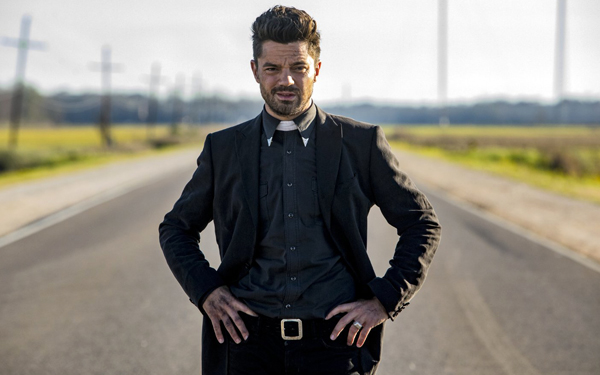Actor and executive producer Seth Rogen (Superbad and Pineapple Express) and show runner Sam Catlin (Breaking Bad) did what fans of the comic book series Preacher thought impossible. They adapted Garth Ennis’s comic for the small screen, and created season one as a prequel to Garth’s storyline.
The AMC show stars Dominic Cooper as Jesse Custer, a man possessed by a hybrid angel/demon, and his volatile hell-raising girlfriend Tulip O’Hare, played by award-winning actress Ruth Negga.
The writers crammed a lot of craziness, fire and brimstone into the first season. And this looks set to continue in season two, as the cast embarks on a road trip to find God.
Speaking at the SXSW 2017 “Making of Preacher” interview session hosted by Terri Schwartz, Seth Rogen, Sam Catlin and Garth Ennis discussed trusting your instinct, knowing where to draw the line, and translating the ideas in your head.

SXSW 2017 “Making of Preacher” interview session. Photo credit: Donna Marie Miller
Schwartz: Welcome back to SXSW. You guys premiered the Preacher pilot here last year, right?
Rogen: Yeah, one year ago we showed the pilot here, and it was one of the most stressful days of my life. But it went well. Thank God we’re back.
What was the moment when you realized “Ok, this is how we can bring this to life in a way that no one has done before?”

Seth Rogen.
Credit: Donna Marie Miller
Rogen: The truth is, we pursued it for years. The first meeting Evan and I had for Preacher was in our trailer while we were filming Pineapple Express in 2006. Then television went from being like the thing you watch on Thursday nights to like an amazing platform to do incredibly innovative things that you probably couldn’t even do in movies..
Ennis: A lot of executives who were further down the ladder the first time around, who were desperately trying to persuade their bosses that Preacher would work and it was the way to go, all of a sudden found themselves a bit higher up the ladder. And they were now able to say “This is the thing to do…Its time has come.”
Sam, you once described the comic as “profane, perverse and psychotic.” Did you break boundaries for the sake of breaking boundaries?
Rogen: I don’t think you ever want to do something just for the sake of doing that thing.
We wanted a show that was audacious. I think when you’re reading the comics there are a lot of things that just can’t believe you’re seeing, you can’t believe you’re reading. You just can’t believe the story’s going in that direction. Those were things that we really wanted to have in the show.
When something is potentially on for years and years, it really has to have some emotional grounding, so it can never feel like you’re doing anything for the sake of doing it. It always has to feel like it’s born of character and story and emotion.
But once we feel like we have that, then we like to try to push it to the most original place that we can. Because there is so much on TV right now, originality is one of the beacons that calls people.
There are a lot of great things on TV right now, but there’s not a lot of great things that you’ve also never seen anything like them before. And that’s what we’ve talked a lot about trying to do.

Joseph Gilgun as Cassidy in Preacher. Photo by Skip Bolen/AMC/Sony Pictures Tel – © 2017 AMC Network Entertainment LLC. and Sony Pictures Television Inc. All Rights Reserved.
Garth, what are your thoughts on some of the changes that were made?

Garth Ennis.
Credit: Donna Marie Miller
Ennis: I think they made sense out of things in the comics that are just taken as given. I like the way that I can see that Jesse’s life as a preacher has grown over time. I like the fact that reasons are given for Tulip and Cassidy to be there, rather than just being coincidence.
In the comic book, everyone meets up by chance. I think I was just trying to get it rolling as fast as I possibly could. And also, I was 24 when I wrote that stuff. When you’re 24 you’re just thinking, “Let’s get on with it.”
On the show you’re going to need much more material. So it’s obvious there are going to be new things; there are going to be changes. I think they’ve come up with the right ones.
You set up many mysteries in season one. Did you have to stop yourselves from including too many?
Rogen: I think the first season deals with a lot with Jesse’s father’s side of the family. I think in season two we start to ask the question, “what was his mother’s side of the family like?”
How did you develop God as a character for season 2?

Sam Catlin.
Credit: Donna Marie Miller
Catlin: It’s very challenging, because in Preacher God isn’t an idea, he’s not a way of looking at life; he’s a guy who’s out walking around. He’s missing and Jesse’s gonna be on his trail.
Have you guys received any notes from AMC telling you to lean away from some of these elements?
Rogen: We have not received a lot of that, honestly. They want the show to be good and they want it to represent what we all set out to make in the first place.
We’ve had a couple of ideas that required like maybe a 10-minute phone call…But I do not feel like we are neutering our ideas, or holding back on the content that we want to be putting out there. If anything I’m shocked we are able to push it as far as we do.
Garth what has been your response to seeing some of these scenes coming to life, and knowing that some of the more controversial things are coming down the road?
Ennis: When we did the comic it was more by stealth. The imprint of DC Comics who did it—at Vertigo—had very sympathetic people in charge, but the actual publishers, the actual executives in charge of DC Comics overall, were not sympathetic. We got as far as we did by stealth, not by meaning to, but by not getting noticed by the wrong people. Now the right people are in charge, and that’s why the TV show is able to go as far as it can.

Dominic Cooper as Jesse Custer and Ruth Negga as Tulip O’Hare in Preacher. Photo by Marco Grob/AMC – © 2017 AMC Network Entertainment LLC. All Rights Reserved
Do any of you have any concepts that you’d love to bring to life if you didn’t have to worry about backlash or limitations?
Ennis: Ninety percent of what I do is done without any restrictions but my own. In fact, in a couple of instances I’ve written stories where I’ve run into my own limits before I run into those of the publishers.
Rogen: Something I learned years ago is that the idea that you’re joking about between takes, when you say “no, we can’t do that,” that’s exactly what we should be doing. That’s the type of thing that people will really respond to.
I’ve seen that happen first-hand, where there have been jokes between takes, and I’ve said, “You know what would be funny? If one of us said this: but that would be just too fucked up.” Then one of the other actors just says it the next day and it winds up in the movie, and being the line that people think we thought of for years and year and years.
If your instinct is “we can’t do that, but it would be really good to do that,” then you should do that.

Graham McTavish as The Cowboy in Preacher. Photo by Skip Bolen/AMC/Sony Pictures Tel – © 2017 AMC Network Entertainment LLC. and Sony Pictures Television Inc. All Rights Reserved.
Audience Member: How do you know where to draw the line?
Rogen: You’re asking a guy who almost started a war with North Korea! [The Interview in 2012.]
I guess you know I’m not the best person for knowing where that line is. I’ve found that you don’t know where the line is until you look back, and think “oh, that’s where the line was—a thousand miles back there?”
Yeah, the line is not a deal. We talk more about, “Will the audience get this?” Or, “Have we done the work we need to do to translate this idea from our brains into the eyes and ears of an audience?” That’s what I think we do the most.
It’s almost like translating. The challenge has been taking into consideration every way they might not interpret it correctly, and taking into consideration every way that you might not do your job correctly in making them understand this thing that you want them to understand
But to me there is no idea that is not explorable. There’s only the limits of your abilities to articulate why you feel it’s an idea worth exploring, and articulate why you think the audience should be listening to your take on this specific idea.
Ennis: I would say when you’re talking about creativity, start with where you want to get to, and worry about the rest later. Because when you try to get published, or when you try to get your film distributed or whatever it is you’re doing, you’ll find out pretty soon where the limits are then. But you shouldn’t be thinking about that when you’re putting a story together.
There’ll be plenty of time to have people tell you “no.” But in the beginning, do what you want.
By Donna Marie Miller.
Preacher Season 2 airs on AMC in June.
Featured image: Dominic Cooper as Jesse Custer in Preacher. Photo by Skip Bolen/AMC/Sony Pictures Tel – © 2017 AMC Network Entertainment LLC. and Sony Pictures Television Inc. All Rights Reserved.
[addtoany]
Before You Go


